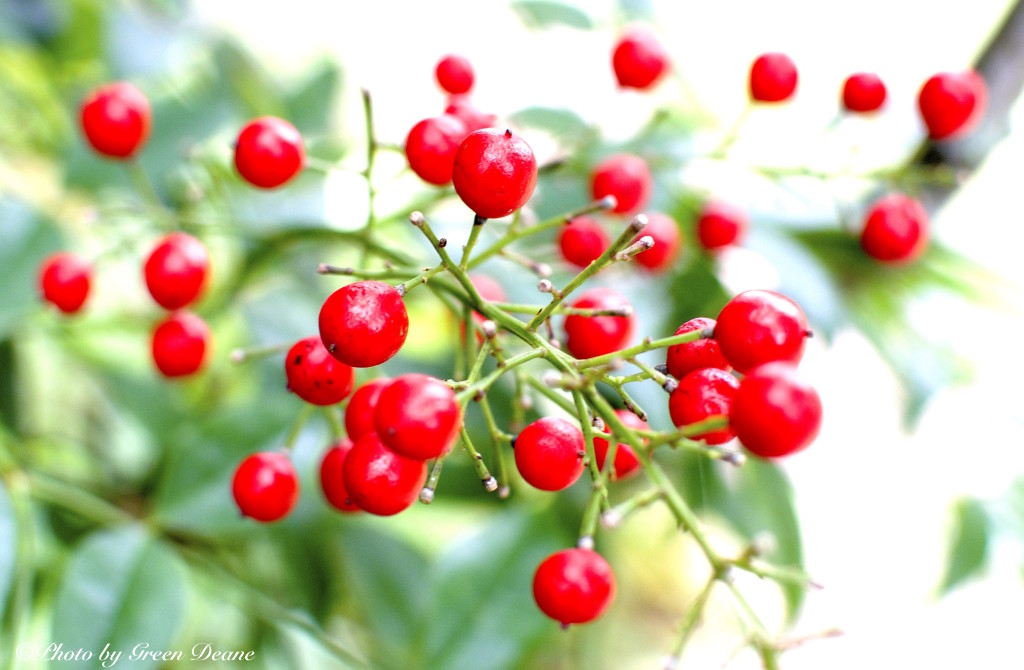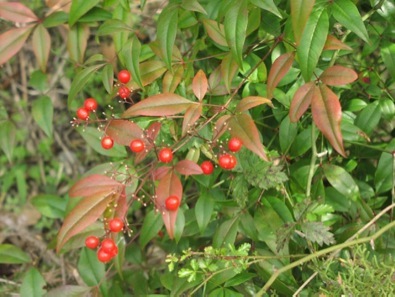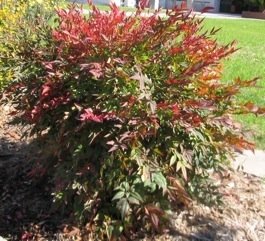Not So Heavenly Bamboo: Nandina
It’s not heavenly nor is it a bamboo, but Heavenly Bamboo is an edible, barely.
Naturalized in many part of the world including the southern United States, it is also a very common landscape ornamental known for its showy color-changing foliage. Young leaves are edible after boiling in two changes of water like poke weed. Whether the berries are edible is in dispute, some say yes, some say no. However, most agree that all they will give you is a mildly upset tummy. In fact that is probably a clue to the berry’s edibility.
A native of Japan, central Asia, and India, the Nandina domestica is a shrub that grows in a clump. It has very distinctive compound leaves that are lance-shaped on multiple non-branching stems. It gives the plant a very lacy appearance. In the fall or spring depending on where you live there are large panicles of small flowers that turn into green berries which ripen to red. There are many cultivars which brings up the issue, what do we call it? Heavenly Bamboo? Sacred Bamboo? Nandina? Or the Japanese name, Nanten? Since it is the only species in its genus I will index it under Nandina.
Regardless of what you call it it was introduced into Japan from China before 1600 and was in the United States by 1804. It prefers rich soil and will not do well in sand. Other than that preference it is a very tough and adaptable plant. It has few pests or diseases, likes sun or shade, and can live to be over a century old. While associated with milder climates it will grow back seasonally from roots in cooler climes. Nandina can be found as far north as Ohio, Maryland, California, up the west coast and in Europe from England south.
The Nandina domestica also attracts wildlife, such as bees to the flowers and several species to its fruit including mocking birds, cedar waxwings and robins. There is one case of cedar waxwings dying after eating only Nandiana berries in 2009. They were all in one yard and to date that is the only report. Cause of death was cyanide in the seeds and the birds had eaten a toxic dose because other food was in short supply. (See study below.) Nandina is also listed as a Class I invasive species in Florida and Texas. There is, however, some debate over that. Some say the plant was declared “invasive” by the very groups that profit by its removal (from state funding) so whether it is invasive or not may be a matter of opinion.
Now let us return to edibility. The leaves are easy to figure out, young and tender boiled twice. Not great but edible. But what of the fruit? Why do some authorities say they are edible and some say they are not, though it is agreed the most they give you if eaten raw in small amounts is a stomach ache. This is pure speculation on my part but since the plant does have hydrocyanic acid in it the Nandina might be like the red elderberry. With that plant the seeds in the berries have hydrocyanic acid and can upset your stomach or make you more sick if consumed in large amounts. However, if you remove the seeds from the red elderberries the pulp is edible. And indeed, Paghat of Paghat.com in Washington says he has removed the seeds from the Nandina berries and made jelly out of them et cetera.
“They can then be used pretty much as other not-so-tasty berries,” Paghat wrote to me, “like mountain ash or hawberries, mixed with sweeter berries or apples improves them lots for jelly; or mixed with cooked pumpkin in a pie recipe.”
Edible pulp and non-edible seeds can create conflicting reports of berry edibility and berry toxicity. All in all, the Nandina is not prime wild eats, but it is very common and persists throughout most of the season. That makes it an edible to know, if prepared correctly. Incidentally, its aromatic wood is considered by the Japanese as excellent for toothpicks. The Japanese also plant it outside home entrances to comfort those who have bad dreams… apparently seeing the pretty shrub scrubs away your nightmare. There is also one odd thing about an alkaloid the plant has, called nantenine. Curiously, that alkaloid blocks the effects of the street drug called Ecstasy. It does make one wonder how they figured that out.
Nandina is an anglicized version of the Japanese name, nanten. Domestica means for or of the house. It is pronounced Nan-DEE-nuh do-MESS-tee-ka.
Green Deane’s “Itemized” Plant Profile
IDENTIFICATION: An evergreen erect shrub to 10 feet high and five feet wide, multiple bushy cane-like stems that resemble bamboo, leaves alternate, bipinnately compound dividing into many 1 to 2-inch, pointed, oval leaflets. Young foliage often pinkish, and soft light green, can be tinged red in winter. Terminal clusters of tiny white-to-pink flowers in early summer, round berries, 1/3 inch in diameter, two-seeded.
TIME OF YEAR: Young leaves any time, berries in fall and winter.
ENVIRONMENT: Highly adaptable disliking only sandy soil.
METHOD OF PREPARATION: Young leaves boiled in two changes of water, berries without the seeds can be made into jelly but is better added to other fruits concoctions.
Toxicity Due to Nandina domestica in Cedar Waxwings (Bombycilla cedrorum)
Many cedar waxwings were found dead in a yard in Thomas County, Georgia, in April, 2009. Five of these submitted to the Tifton Veterinary Diagnostic and Investigational Laboratory, where they were examined grossly and microscopically.
On gross examination, the gastro-intestinal tract of these birds were distended by intact and partly digested berries of Nandina domestica Thunb. (Heavenly Bamboo). These berries were the only ingesta present within the digestive tract of these birds. In all the examined birds, there were gross pulmonary, mediastinal, and tracheal hemorrhages. Microscopically, several tissues and organs including the lungs, liver, kidney, proventriculus, ventriculus, uvea of the eye, heart, the meninges and the brain were diffusely congested and hemorrhagic. The congestion, hemorrhage and edema were very marked in the lungs.
The gross and microscopic findings are consistent with lesions associated with cyanide toxicity. N. domestica berries may contain large quantities of cyanogenic compounds. For most cultivars of N. domestica, cyanogenesis is the most important intoxication factor. As seen in these cedar waxwings, in birds that die from cyanide chemical toxicosis multiple tissues or organs, particularly the lungs, may be hemorrhagic and edematous, and congested with blood. Cyanide is a mitochondrial toxin that impairs cellular respiration, causing morbidity or mortality within a very short time.
During winter and spring, when the food supplies are low or out of season, cedar waxwings migrate in huge numbers from their breeding grounds in the northern U.S. and southern Canada into the more southerly regions, where they feed almost exclusively on fruits. They often eat voraciously, until they can hold no more, and may become intoxicated from eating large quantities of over-ripe fruit.
N. domestica produce vast quantities of bright red berries, which last through the winter into the spring in this region, attracting hungry birds whose food is in short supply during this time of the year. Toxicity associated with N. domestica has not been previously reported in the cedar waxwings. However, due to their voracious feeding behavior, these birds had eaten toxic doses of the readily available berries of N. domestica.




